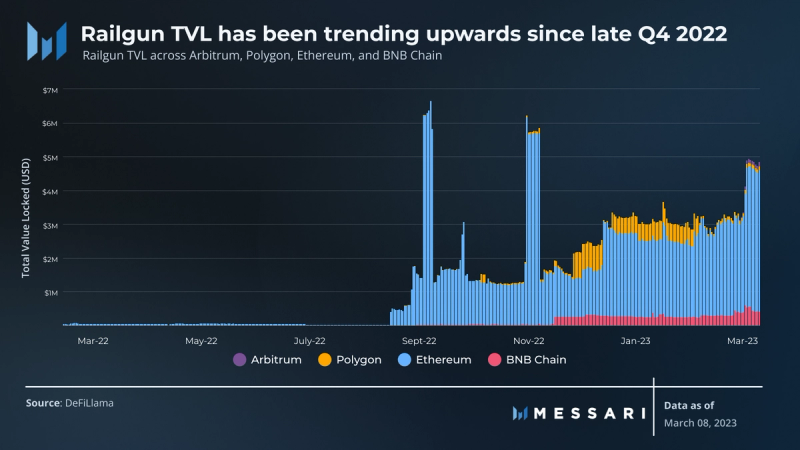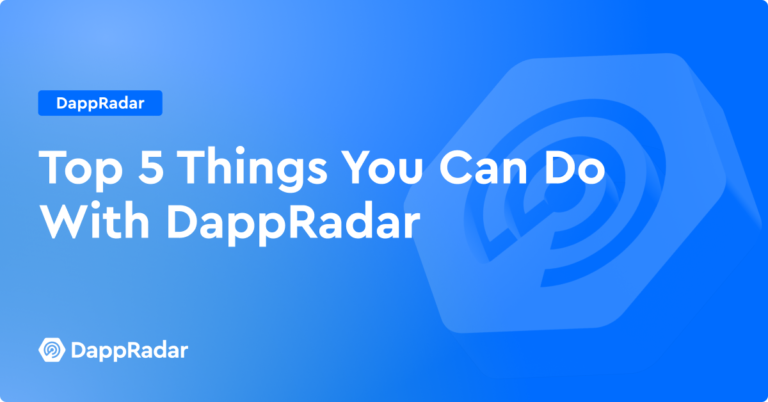Key Insights
- RAILGUN is a privacy middleware (on Ethereum, Polygon, Arbitrum, and BNB Chain) that can be integrated directly with applications and wallets.
- Currently, the most popular point of contact for RAILGUN is Railway, an independent wallet that enables private transactions and anonymous swaps (via decentralized exchange (DEX) aggregator 0x).
- While there are a number of competitors in the privacy space, RAILGUN is uniquely on base layers (e.g., Ethereum) and can integrate directly with external smart contracts (applications).
- While RAILGUN is still in development and only started experiencing usage in July 2021, integrations with projects and existing wallet providers (offering an “incognito mode”) are promising avenues for growth.
Transparency lies at the heart of public blockchains. It allows distributed ledgers to replace trusted third parties, unlocking new design spaces in everything from money and finance to cloud storage and computation. The tradeoff, of course, is the attendant lack of privacy. Any given transaction on the blockchain reveals a user’s position and financial history. The pushback against revealing such sensitive and compromising information is unsurprising. What has been surprising, however, is the lack of on-chain privacy solutions that are compelling, comprehensive, and easy to use.
To meet this need, RAILGUN was developed as a unique privacy middleware that can be directly integrated with applications and wallets. Its open-source system uses zero-knowledge (ZK) cryptography to enable private asset storage, transactions, and smart contract calls on base layers (currently, Ethereum, BNB Chain, Arbitrum, and Polygon). While the project is just in its infancy, the promise to end users is clear – instead of dealing with outside privacy chains or rudimentary mixers, users have access to native, frictionless privacy. By embedding itself into existing workflows, RAILGUN could begin to change the default mode of blockchain use, from public to private.
Project History
In July 2021, a (mostly doxxed) group of contributors released open-source code for the RAILGUN Privacy System. A month later, the RAIL token was airdropped, and governance code was deployed, creating the RAILGUN DAO. Shortly thereafter, the RAILGUN DAO’s first vote was to launch the RAILGUN Privacy Contract on Ethereum.
Since then, RAILGUN DAO contributors have continued to develop the RAILGUN Privacy System, releasing the RAILGUN Privacy System 1.0. Additionally, RAILGUN began its multichain expansion, launching on BNB Chain and Polygon. In late-June 2022, RAILGUN was tested for the first time by partner project Railway, a privacy-focused wallet that uses the RAILGUN SDK. In November 2022, the rollout of RAILGUN 2.0 began.
How It Works
Shielding
To use the RAILGUN Privacy System, users must first “shield” their assets. Users (individuals, smart contracts, etc.) send assets (currently any non-rebasing ERC-20 tokens or NFTs) to their public RAILGUN 0x address. They can then shield these assets to any private RAILGUN 0zk address by sending them to RAILGUN’s privacy pool, making their particular tokens unidentifiable.
The entire process is non-custodial. An 0zk address is linked to a public 0x address, which is derived from and thus controlled by the same private key.
The DAO treasury charges 0.25% for deposits (“shielding”) and withdrawals (“unshielding”). Once funds are associated with a private RAILGUN 0zk address, they can be sent to another 0zk address within the RAILGUN Privacy System or used in DeFi.
Transacting
To transact within the RAILGUN Privacy System (between 0zk addresses) or use decentralized finance (DeFi), users broadcast encrypted information and pay fees (via the private peer-to-peer Waku network) to a Relayer. Relayers are the EVM addresses that act as public-facing intermediaries by submitting transactions to the underlying blockchain. Anyone can become a Relayer, and they can also set their fee level (by default, a 10% premium to the blockchain’s gas fee). Relayers never custody funds and cannot decrypt or change transaction details.
Transactions within RAILGUN’s Privacy System operate on an Unspent Transaction Output (UTXO) model, similar to that of the Bitcoin network, except everything is anonymized by ZK proofs. In particular, RAILGUN uses Merkle trees to track balances and zk-SNARKS (arithmetic circuits) to prove the validity of a user’s transactions to RAILGUN’s smart contracts.
For RAILGUN-to-RAILGUN (0zk) transactions, the sender, recipient, token type, and transacted amount remain totally private. The publicly visible details are the Relayer address and the destination address, i.e., the respective RAILGUN smart contract (for the given chain).
For transactions involving other smart contracts (e.g., a DEX), the tokens/amount exchanged is also visible. Finally, users can unshield to any 0x address as they can with the typical coin mixer. In doing so, they can anonymously send tokens – linking the transaction to the RAILGUN smart contract address rather than their own.
With this model, RAILGUN’s efficacy depends on the total value held in the system, the number of unique users shielding tokens, and the volume of external transactions. As these metrics increase, linking transactions to particular addresses becomes more difficult.
Integrating
Developers must integrate RAILGUN SDK to allow its Privacy System to interact with their dapps. In particular, developers work with RAILGUN’s Adapt Modules. These extensions to the RAILGUN protocol serve as an intermediary between external contracts and the RAILGUN Privacy System. Adapt Modules extend functionality without impacting the safety of the core system, which allows any external party to implement custom logic.
Additional Features
- Gasless transactions – Gas can be paid entirely in a user’s asset of choice.
- Multi-sends – Users can send multiple token types to a single recipient in one RAILGUN-to-RAILGUN (0zk) transaction.
- Voluntary disclosure – RAILGUN allows users to create a verifiable transaction history (using its ZK technology).
The RAILGUN documentation provides a more technical, in-depth explanation of how RAILGUN works.
Users can access RAILGUN functionality through the Railway wallet. The Railway wallet currently enables asset shielding and unshielding, private intra-RAILGUN transactions, and anonymized DEX swaps through RAILGUN’s 0x integration.
RAIL Token
RAILGUN has three governance tokens, each corresponding to a chain-specific RAILGUN deployment and DAO:
- RAIL (Ethereum)
- RAILPOLY (Polygon)
- RAILBSC (BNB Chain)
Each token governs and receives staking rewards from its respective RAILGUN deployment. Holders are required to stake RAIL to vote on governance. Stakers who interact with the governance contract at least once are called “Active Governors,” and they can earn a share of DAO revenue (0.25% deposit/withdrawal fees). Every two weeks, 2% of the treasury is distributed to Active Governors, in proportion to their amount of staked tokens.
RAIL, the original token, launched with an initial distribution as follows:
- 25% of the supply was airdropped to Ethereum addresses that had donated to select privacy-focused organizations (i.e., the Free Software Foundation).
- 25% to the Right to Privacy Foundation, a charity that funded the initial development of RAILGUN through a grant.
- 50% to the RAILGUN DAO – locked RAIL that can only be minted through a DAO vote.
- In January 2022, the RAILGUN DAO voted to mint 5 million RAIL to raise $10 million from the Digital Currency Group (DCG). The tokens were exchanged without a discount, at market price, and with a two-year lockup.
The entire RAILPOLY and RAILBSC supplies were airdropped to RAIL stakers and liquidity providers in October 2021.
Traction
The Privacy System becomes more valuable (i.e., transactions become harder to link to depositing accounts) as the following metrics increase: the number of unique wallets shielding transactions, total value deposited, and the number of external (DeFi) transactions.

The main point of contact for RAILGUN is the Railway wallet. It currently has the limited functionality of just integrating with 0x. The activity could pick up as RAILGUN progresses in its roadmap and is integrated by more projects, especially with the new, streamlined, Quickstart SDK.
RAILGUN needs growth from two avenues: external projects and individual users. One way to supercharge growth would be to integrate with an existing wallet (e.g., Metamask, Brave, etc.) and offer RAILGUN as a way to transact in “incognito.” RAILGUN could also integrate with more DeFi primitives like on-chain derivatives, yield, and lending, as well as B2B utility like privatized pay-roll and privatized institutional trading.
Roadmap
Privacy System
In late November 2022, the RAILGUN community began its rollout of RAILGUN 2.0. This upgrade aims to improve the internal user experience and add features that will expand the scope of DeFi integrations.
A roadmap item of note from RAILGUN 2.0 is the new, advanced cryptographic (zk-SNARK) circuits. These circuits will result in lower gas fees for private transactions and more complex transaction inputs and outputs regarding token type and recipients.
Integrations and Deployments
As seen in the release of the Quickstart SDK and the announcement of some roadmap items, the RAILGUN community has been dedicating more resources to adding external integrations.
Ren (following the release of Ren 2.0) and zeroDAO are two planned integrations on the Bitcoin bridge side, which could have powerful synergy with direct shielding. It would allow BTC holders to bridge to other chains without associating addresses, effectively creating an anonymous, native Bitcoin bridge.
The other integration in the roadmap is the multisig smart contract wallet Safe (previously Gnosis Safe). Wallets, in general, are the most promising use case, as a RAILGUN integration could allow users to transact “incognito,” linking transactions to Relayer addresses.
Finally, RAILGUN will continue its chain-agnostic ethos, with Solana, NEAR, and Metis all on the roadmap.
Note: Since Arbitrum is an Ethereum rollup, RAILGUN’s Arbitrum deployment will share governance and revenue with the RAILGUN DAO on Ethereum.
Competitive Landscape
Currently, there are four types of on-chain privacy solutions: privacy coins, privacy-focused Layer-1 blockchains, Layer-2 ZK-rollups, and application-level mixer protocols. While RAILGUN is really the first project of its kind, it’s still worth understanding some of the other solutions that may compete for usage and mindshare.
Privacy coins (i.e., Monero and Zcash) are not really direct competitors to RAILGUN. While they do also focus on storing and transacting wealth privately, they don’t have non-native assets or smart contracts on-chain.
Privacy-focused Layer-1 blockchains (e.g., Oasis and Secret Network) are open source and offer smart contract functionality. However, they lack Ethereum’s security, activity, and assets.
Layer-2 ZK-rollups (i.e., Aztec and enterprise-focused Polygon Nightfall) have similar drawbacks of the previous category. They rely on their own validator sets and bridges but are also closed source. While Layer-2s benefit from their respective base layer’s security and from offering lower fees, they have to migrate projects and users to their rollups.
Therefore, the closest competitors to RAILGUN are most likely application-level coin mixers such as Tornado Cash. Tornado Cash specializes in sending certain coins to any addresses on-chain anonymously. With RAILGUN, users cannot only send anonymous transactions to other public addresses (by unshielding to them), but they can send completely private transactions (to other 0zk addresses) and interact anonymously with other smart contracts.
In terms of the core anonymous transaction utility, however, there is some nuance. First off, RAILGUN provides more flexibility than Tornado Cash in terms of supported assets (any ERC-20s) and denominations. On Ethereum, Tornado Cash only allows users to deposit 0.1, 1, 10, or 100 ETH in a single transaction.
Tornado Cash has established a fairly effective moat through its active network. With over 12,000 unique weekly users, Tornado Cash’s high volume makes it more difficult to connect transactions to users. To compete, RAILGUN should lean into its specialty as infrastructure that can be integrated with existing smart contracts. This will make it a more attractive choice for users seeking a complete experience.
Risks
RAILGUN is a novel, complex project with many moving parts. As such, the code itself and its cryptography need to be evaluated carefully. RAILGUN has an open bug bounty of up to $250,000 on its open-source code. Regarding more formal, point-in-time evaluations, cryptography / ZK specialist ABDK (July 2021), Trail of Bits (February 2022), and Zokyo (September 2022) have all conducted audits.
RAILGUN’s network effects cut both ways. In the early stages, users must be careful in sending tokens (avoiding large quantities and unusual tokens) to maintain their privacy. RAILGUN can’t rely on any single large player to drive its initial growth; instead, it will depend on volume and distributed use. On a network such as Ethereum, the fee-intensive shielding process, in terms of L1 fees and the 0.25% shielding fees, may hinder this necessary adoption. For early-stage projects, market share growth should trump cash flow. Thus, RAILGUN DAO governance should consider reducing its fee or even switching to incentivized usage to bootstrap the network effect (privacy).
The Railway wallet is currently the most common way to interact with the RAILGUN system. Further integrations throughout the ecosystem will help to de-risk the reliance on the Railway wallet, while also generally advancing the usage of the RAILGUN system.
Closing Thoughts
Despite its namesake, the world of crypto has typically viewed privacy as an afterthought thus far. However, privacy is quickly becoming more important, with both hostile regulation and real world adoption coming down the pike. While RAILGUN faces its share of challenges in the present, the future success of crypto demands an easy way for users and developers to preserve privacy., RAILGUN already has tooling and technology to make this future a reality — all it needs now is growth.




